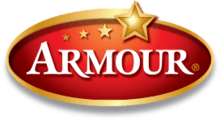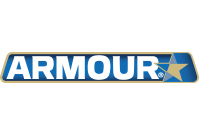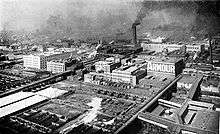Armour and Company
Armour & Company was an American company and was one of the five leading firms in the meat packing industry. It was founded in Chicago, in 1867, by the Armour brothers led by Philip Danforth Armour. By 1880, the company had become Chicago's most important business and had helped make Chicago and its Union Stock Yards the center of America's meatpacking industry. During the same period, its facility in Omaha, Nebraska, boomed, as well, making the city's meatpacking industry the largest in the nation by 1959. In connection with its meatpacking operations, the company also ventured into pharmaceuticals (Armour Pharmaceuticals) and soap manufacturing, introducing Dial soap in 1948.
| Industry | Meatpacking, consumer products, pharmaceuticals |
|---|---|
| Founded | 1867, Chicago, Illinois |
| Founder | Philip Danforth Armour |
| Defunct | 1983 |
| Headquarters | Chicago, Illinois , |
Area served | United States |
| Products | Processed meat, canned food, soap, pharmaceuticals |
| Owner | Philip Danforth Armour family (1867-1920), Frederick H. Prince (1920-1969), The Greyhound Corporation (1970-1983) |
| Website | www |
 | |
| Product type | Processed meat |
|---|---|
| Owner | Smithfield Foods |
| Country | United States |
| Markets | United States |
| Previous owners | Armour and Company (1867-1983), ConAgra (1983-2006) |
| Website | http://www.armourmeats.com |
 Armour Star logo used by Pinnacle Foods | |
| Product type | Canned food |
|---|---|
| Owner | ConAgra Brands |
| Country | United States |
| Markets | United States |
| Previous owners | Armour and Company (1944-1983), The Dial Corporation (1983-2006) |
| Tagline | Any Time is Armour Time |
| Website | http://www.armour-star.com |
Presently, the Armour food brands are split between refrigerated meat (Armour, owned by Smithfield Foods) and canned shelf-stable meat products (Armour Star, owned by ConAgra Brands). The Armour pharmaceutical brand is owned by Forest Laboratories. Dial soap is now owned by Henkel.
History
1863 to 1970


Armour and Company had its roots in Milwaukee, where in 1863 Philip D. Armour joined with John Plankinton, the founder of the Layton and Plankinton Packing Company in 1852 to establish Plankinton, Armour and Company. Together, the partners expanded Plankinton's Milwaukee meat packing operation and established branches in Chicago and Kansas City and an exporting house in New York City. Armour and Plankinton dissolved their partnership in 1884 with the Milwaukee operation eventually becoming the Cudahy Packing Company.[1]
In its early years, Armour sold every kind of consumer product made from animals: not only meats but also glue, oil, fertilizer, hairbrushes, buttons, oleomargarine, and drugs made from slaughterhouse byproducts. Armour operated in an environment without labor unions, health inspections, or government regulation. Accidents were commonplace. Armour was notorious for the low pay it offered its line workers. It fought unionization by banning known union activists and by breaking strikes in 1904 and 1921, employing African Americans and new immigrants as strikebreakers. The company did not become fully unionized until the late 1930s when the Meatpacking Union succeeded in creating an interracial industrial union as part of the Congress of Industrial Organizations.

During the Spanish–American War (1898), Armour sold 500,000 pounds of beef to the US Army. An army inspector tested the meat two months later and found that 751 cases contained rotten meat. This resulted in the food poisoning of thousands of soldiers.[2]
In the first decade of the 20th century, the young Dale Carnegie, representing the South Omaha sales region, became the company's highest-selling salesman, an experience he drew on in his best-selling book, How to Win Friends and Influence People.[3]

In the early 1920s, Armour encountered financial troubles and the Armour family sold its majority interest to financier Frederick H. Prince. The firm retained its position as one of the largest American firms through the Great Depression and the sharp increase in demand during World War II. During this period, it expanded its operations across the United States; at its peak, the company employed just under 50,000 people.
In 1948, Armour, which had made soap for years as a byproduct of the meatpacking process, developed a deodorant soap by adding the germicidal agent AT-7 to soap. This limited body odor by reducing bacteria on the skin. The new soap was named Dial because of its 24-hour protection against the odor-causing bacteria. Armour introduced the soap with a full-page advertisement using scented ink in the Chicago Tribune. During the 1950s, Dial became the best-selling deodorant soap in the US. The company adopted the slogan "Aren't you glad you use Dial? Don't you wish everybody did?" in 1953. In the 1960s, the Dial brand was expanded to include deodorants and shaving creams. Because of the popularity and strong sales of Dial brand, fueled by magazine, radio, and television advertising, Armour's consumer-products business was incorporated as Armour-Dial, Inc. by 1967.
In 1958, William Wood-Prince, a cousin of Frederick H. Prince, became president of Armour and Company.
.jpg)
1970-2000
In 1970, Armour and Company was acquired by Chicago-based bus company Greyhound Corporation[5] after a hostile takeover attempt by General Host Corporation[6] a year before. In 1971, Greyhound relocated Armour's headquarters from Chicago to Phoenix, Arizona, to a newly built $83-million building. Rock icon Stevie Nicks' father, Jess Nicks, who was a Greyhound executive, became president of Armour.
In 1978, Greyhound sold Armour Pharmaceuticals to Revlon.[7] Revlon sold its drug unit in 1985 to Rorer (later known as Rhône-Poulenc Rorer).[8] Forest Laboratories acquired the rights to the Armour Thyroid product from Rhone-Poulenc Rorer in 1991.[9] The remaining assets of Armour Pharmaceuticals are now part of CSL Behring.[10] Armour's Factor VIII product "Factorate" was widely reported as infecting thousands of hemophiliacs worldwide with HIV during the 1980s;[11][12] there have also been allegations that the firm suppressed evidence showing the product was defective.[13] As a result, there have been lawsuits, inquiries and criminal charges.
Greyhound's rapid diversification and frequent unit restructurings led to erratic profitability. In 1981, John W. Teets was appointed chairman of Greyhound and he began selling unprofitable subsidiaries. After meatpackers struck at the Armour meat-packing plants in the early-1980s, Teets shut 29 plants and sold Armour Food Company to ConAgra in 1983,[14] but kept the Armour Star canned meat business. Armour-Dial continued to manufacture the canned meat products using the Armour Star trademark under license from ConAgra.
In 1985, Greyhound acquired the household products business of Purex Industries, Inc. in 1985[15] and was combined with Armour-Dial to form The Dial Corporation.
In late 1995, parent company Greyhound (renamed in 1991 as The Dial Corp) announced its intention to split the company and spin-off the Dial consumer-products business. After the spin-off, Dial's now former parent company was renamed Viad Corp, consisting of the service businesses. The Dial consumer business was reborn as the new Dial Corporation, relocating its corporate offices to Scottsdale, Arizona, adjacent to its long-time research and development facility. Under new CEO, Malcolm Jozoff, a former P&G manager, the new Dial Corporation underwent major layoffs in the fall of 1996 and a series of financially disastrous acquisitions the following four years. In 2000, Jozoff resigned and was replaced by Herbert Baum[16] with a mandate from the board of directors to find a suitable buyer for the company.
2000 to present
Dial was acquired by Henkel KGaA of Düsseldorf, Germany in March 2004. The food business of Dial, including Armour Star canned meats, were sold to Pinnacle Foods in March 2006.[17] In 2007, Pinnacle Foods was acquired by the Blackstone Group, a New York City-based private equity firm.[18]
In July 2006, ConAgra sold most of their refrigerated meats businesses, including the Armour brand, to Smithfield Foods.[19]
In June 2018, Conagra announced it would acquire Pinnacle Foods for $8.1 billion.[20]
See also
- Treet
- Armour Refrigerator Line
- Desiccated thyroid extract (Armour Thyroid)
References
- "Archived copy". Archived from the original on 2013-10-30. Retrieved 2014-02-11.CS1 maint: archived copy as title (link)
- Zinn, Howard. A People's History of the United States. New York: Perennial, 2003. p.309 ISBN 0-06-052837-0
- How To Win Friends And Influence People, by Dale Carnegie, Introduction by Lowell Thomas, p. 9, Copyright 1964
- Armour Company, and Armour Company, Chicago. Armour's Food Source Map : The Greatness of the United States Is Founded on Agriculture. Chicago: Armour & Company, 1922. https://collections.lib.uwm.edu/digital/collection/agdm/id/1967
- Lueck, Thomas J. (June 11, 1983). "Greyhound to Dispose of Armour". The New York Times. Retrieved 2014-07-07.
- Belair, Felix Jr. (18 January 1973). "SEC sues General Host and 9 over Armour bid". The New York Times. Retrieved 19 March 2018.
- "Revlon Set to Buy Armour Druz Units". 6 July 1977 – via NYTimes.com.
- Crudele, John. "RORER BUYS DRUG UNIT OF REVLON".
- Reuters. "COMPANY NEWS; Rhone Sells Rights".
- "Caliber Associates - Clients". Archived from the original on 2016-03-03. Retrieved 2013-09-09.
- Society, Eric Feldman Associate Director New York University's Institute for Law and; Health, Columbia University Ronald Bayer Professor Joseph L. Mailman School of Public (5 March 1999). "Blood Feuds : AIDS, Blood, and the Politics of Medical Disaster: AIDS, Blood, and the Politics of Medical Disaster". Oxford University Press, USA.
- Information, Reed Business (17 July 1986). "New Scientist". Reed Business Information.
- "Firm squelched study showing risk of HIV in hemophilia drug". AIDS policy & law: 5. 20 October 1995. PMID 11362848.
- Hollie, Pamel (30 June 1983). "Greyhound Selling Armour". The New York Times. Retrieved 11 March 2018.
- Hicks, Jonathan (22 February 1985). "Greyhound to buy Purex Division". The New York Times. Retrieved 11 March 2018.
- Winter, Greg (9 August 2000). "2 officers resign as Dial says profits will be off". The New York Times. Retrieved 14 March 2018.
- "Pinnacle Foods Group acquires Armour dry food products". Food Ingredients First. 2 March 2006. Retrieved 14 March 2018.
- "Blackstone Group buying Pinnacle Foods". NBC News. 12 February 2007. Retrieved 14 March 2018.
- "ConAgra Foods to Sell Refrigerated Meats Businesses to Smithfield Foods for $575 Million; Sale Includes Butterball, Eckrich and Armour Brands". Business Wire. 31 July 2006. Retrieved 14 March 2018.
- Naidu, Richa. "Conagra to buy Pinnacle for $8.1 billion, creating frozen food powerhouse". Reuters U.S. Retrieved 2018-07-14.
Further reading
- Arnould, Richard J. "Changing patterns of concentration in American meat packing, 1880–1963." Business History Review 45.1 (1971): 18-34.
- Gras, N.S.B. and Henrietta M. Larson. Casebook in American business history (1939) pp 623–43.
- Warren, Wilson J. Tied to the great packing machine: The Midwest and meatpacking (University of Iowa Press, 2007).
| Wikimedia Commons has media related to Armour and Company. |